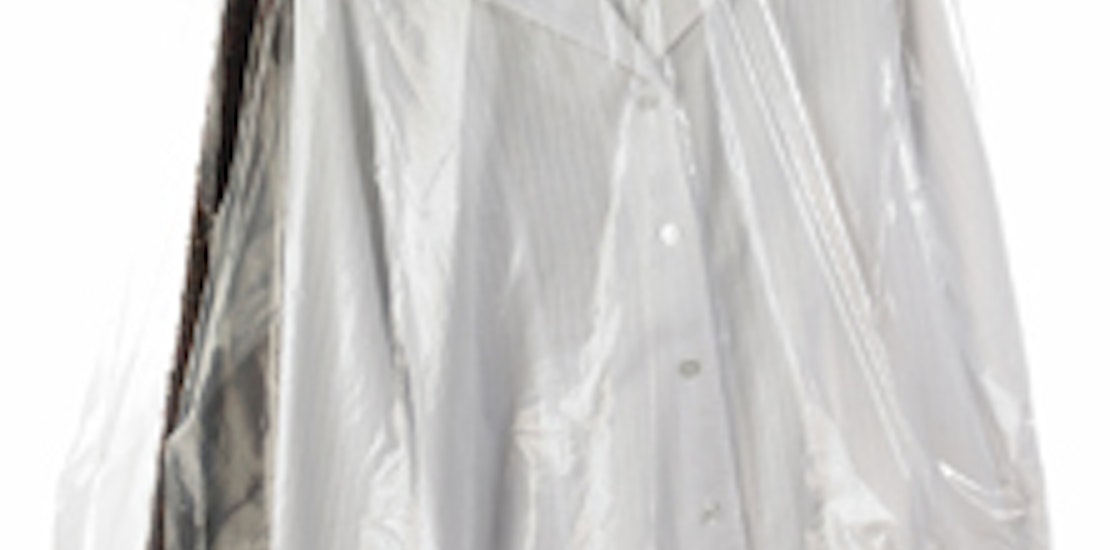All Washed Up: The Real Dirt on Dry Cleaning

Some rules are okay to break. Eating ice cream before dinner probably won’t spoil your appetite (unfortunately), and throwing your “dry-clean only” clothes in the washing machine probably won’t ruin them. Of course, there’s a time and a place for professional cleaning services?sometimes DIY just won’t cut it?but understanding what dry cleaning actually entails may make it less attractive, if cost alone isn’t enough to do so. It’s time to dissolve some of the mystery surrounding this obscure process.
The first misconception about dry cleaning is that it’s, well, dry. True, there’s no water involved, but the clothes you drop off are soaked in a liquid solvent, according to Debra Luhring and Nate Marks of TLC Home. In 1855, Jean Baptiste Jolly, a French dye-works owner, noticed that the dirt on his tablecloth disappeared after his maid accidentally knocked over a kerosene lamp. He decided to offer a new service at his company, “dry cleaning,” using gasoline and kerosene instead of soap to clean clothes and fabrics.
Stains require immediate treatment. Even those powerful chemicals your dry cleaner uses won’t be much help if you spill coffee all over your blouse and don’t take care of it yourself first. You might as well finish the job and save your money, as long as you use an appropriate stain remover that won’t damage the fabric.
The AFL-CIO reports that women still make about seventy-eight cents for every dollar a man earns, on average. And, according to Chan, we spend more of that income on dry cleaning than our male peers do. In a sampling of New York City cleaners, the Wall Street Journal found that women usually pay twice as much as men, even for similar garments like dress shirts. “Gender-pricing [in the dry-cleaning industry] has been going on for years,” Chan quotes Ron Berry, senior vice president at the Council of Better Business Bureaus, as saying.
Don’t Get Taken to the Cleaners
There’s pretty strong evidence out there against dry cleaning as the best treatment for even the most delicate fabrics. It’s pricey, unhealthy, harmful to the environment, and (especially for women) an all-around rip-off. Considering even the time and cost of experimenting with home dry-cleaning kits and the risk of ruining valuable clothing items, in most cases, bypassing the cleaners is a smart move.
Make a Comment
 by
Tfurr64 | Fort Smith, AR
by
Tfurr64 | Fort Smith, ARWhen washed at home some items do not fair as well as others whether I hand or machine washed them. I do not buy many that have dry clean attached to them but would like to hear from those who have found good at home cleaners for dry clean only clothing.
 by
kellenmom | OMAHA, NE
by
kellenmom | OMAHA, NEWow most of you all are a lot more brave than I. I am afraid to hand wash or machine wash my dry clean only items. I too leave them in a pile and they don't get worn as much as they should. The best approach is to avoid buying those clothes.
 by
JBallantine | Redmond, WA
by
JBallantine | Redmond, WAIf I can't throw it in the washer and dryer I don't bother to purchase it, same goes for needing ironed. I have created a lifestyle that is easy "wash and wear" for us and by doing that have saved a ton of not only money, but headache as well!
 by
Bunny26 | LAS VEGAS, NV
by
Bunny26 | LAS VEGAS, NVI try my best to buy clothes that I know can be machine washed and hand washed.
 by
momof3intn | cleveland, TN
by
momof3intn | cleveland, TNIve never liked paying for dry cleaning and most of my clothes with these labels tend to sit in a pile for months after they are worn before I get them cleaned. I have used at home kits but they always made me nervous and didn't want to ruin my clothes. I will definitely use them from now on!
 by
raisedbywolves | Orangevale, CA
by
raisedbywolves | Orangevale, CAI'm a cashmere fiend. I use Eucalan or Orvus and hand-wash my finest cashmere, or machine wash the everyday woolens. Just be careful washing lined jackets/slacks/dresses - many linings are made from non-washable fabric. I ruined the lining on a designer cashmere jacket by machine washing it - though the cashmere is fluffier and softer than ever, so I'll just remove most of the lining. Wool/cashmere/camel-hair can "felt," so they *should* be washed individually, by hand, with minimal wool-on-wool contact. Gentle. Shave any pilling while still damp and re-shape before drying, and you get soft, non-toxic, pleasant-smelling results, better than dry-cleaning. Sometimes, you can change the shape or size by hand-washing, too (stretch the top and bottom back into shape, but let the waist stay nipped-in, shrink too-large wools, or stretch too-small sweaters up a size - results vary, and always stretch gently and evenly, ALWAYS gently supporting any seams).
 by
catsmeow | Chicago, IL
by
catsmeow | Chicago, ILI have recently started using the cheap price cleaners for items that I don't won't to wash or ruin. Over the years I have washed dry clean only items and have used the home kits. The home kits worked well for sweaters but I wouldn't use them for stain items. Mostly, just to get the smell of smoke out of them. I may frequent the cleaners twice a year. I don't have a washer and dryer at home so I use the local laundromat. I choose my pieces wisely for the cleaners.
 by
msfriendly | MONROE, WI
by
msfriendly | MONROE, WIIf something says "dry clean only" I dont buy it. I've heard that the items that say just "dry clean" are OK to hand wash yourself. I haven't been to the dry cleaners for years. I don't like the chemicals. I find I can wash things on delicate or the hand wash setting on my machine and everything has turned out great.
 by
MyEmptyCanvas | KOSCIUSKO, MS
by
MyEmptyCanvas | KOSCIUSKO, MSI've only taken my clothes to the cleaners a handful of times... that was over 10 years ago. I never did care for the Dry Cleaners to much, knowing that I had a perfectly good washer & dryer and home, but I think that at the time, those items I took were new and I didn't want to risk ruining, but after a while, I started hand washing those delicate items and haven't been to a dry cleaners since. They charge to much anyway...
 by
rbp1952 | Houston, TX
by
rbp1952 | Houston, TX20 yrs ago, I spent ~ $125.00 monthly. I HATED to iron cotton shirts, and they looked better from the cleaners. All my suits said "Dry Clean Only". I wore shirts 2-3 times per laundering and suits 4-6 times between dry cleaning. Then the $1.19 & $1.29 per piece cleaners popped up. I found I could cut my cleaning bills in half. The problem was clothes were nicely pressed & ironed, but not always clean. Also, they were not really $1.19 - there a couple of other odd charges per piece. Still, they were cheaper than the standard dry cleaners. There are a couple of good old fashioned cleaners in the area, but now the cost runs $250. - $300. monthly. Now I spot treat collar & cuff rings, wash, hang dry & iron cotton shirts myself. They feel good all clean & crisp. I look for cotton, linen or silk slacks & jackets that I can wash at home and I try to stay from dry cleaning. By doing half a cleaning job, the cut rate cleaners have cut themselves out of business.





 (1)_05192023144508.jpg?max-w=432&max-h=220&fit=crop&auto=format)





_01252024061712.jpg?max-w=432&max-h=220&fit=crop&auto=format)

_10242023164832.jpg?max-w=432&max-h=220&fit=crop&auto=format)


_08172023152001.jpg?max-w=432&max-h=220&fit=crop&auto=format)


 (6)_07082023175312.jpg?max-w=432&max-h=220&fit=crop&auto=format)

 (37)_05032023114523.jpg?max-w=432&max-h=220&fit=crop&auto=format)